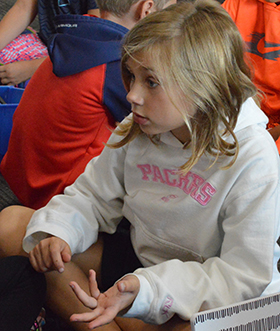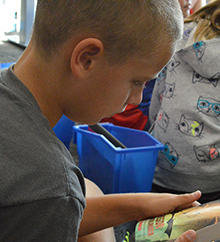Brown Elementary School fourth-grader Layla Funk looked up from the book she was reading to consider the question: “How has your school helped you become a great reader?”
“You have to have a good book you like with you and have an interest in it,” Layla answered, before turning back to her chapter.
Developing good readers is an objective for schools -– put in simple terms by Layla –- that is proving increasingly complex. Statewide, just 44.1 percent of students were proficient in reading in third grade on the M-STEP taken last spring, down 1.9 percentage points from the prior year. Third grade is targeted by new legislation as when to hold students back if they aren’t reading at grade level.
In West Michigan, superintendents and educators among the 100 districts in Region 3 have zeroed in on boosting proficiency to 80 percent, through work by Reading Now Network, a collaborative effort to share instructional practices to benefit all students. However, recently released M-STEP scores in reading were disappointing.
Related Stories:
- Tips to Parents: How to Help Your Child’s Reading
- Schools Gear Up to Prepare for Third-Grade Reading Law
- Laser Focus on Reading Produces Good Results
Student proficiency scores in 2017 decreased in all but fifth grade, which showed an increase of .5 points. Decreases ranged from .9 points in eighth grade to 2.3 points in seventh grade. A three-year comparison of English language arts scores shows decreases were 5.9 points for third grade. In Kent ISD schools, 48.6 percent of third-graders were proficient compared with 50.2 percent last year.
Many factors play into reading proficiency, including poverty rates and language barriers for English-language learners, and schools struggle to rise above these demographics. Brown Elementary is not poverty-free — its free and reduced lunch rate is 21 percent — but it has achieved above 90 percent proficiency for the past several years, posting 93.6 percent for the 2016-2017 school year. Reading Now Network has studied schools that are outliers, including Brown, when it comes to student achievement in relation to demographics.
So what’s the secret at Brown, a 2015 National Blue Ribbon-winning school that has been studied by Reading Now Network as an overachiever? What instructional practices lead students to such high achievement? (Districtwide, Byron Center’s third-grade reading scores are also well above average. At Marshall, 71.2 percent were proficient, and at Countryside, 70 percent.)

Shelves of Books to Choose From
Visit Brown, and one thing stands out: Students are reading books they like.
“I think they come into class and they can’t even wait to read. They know the routines by now and they can’t wait to get into books,” said teacher Tara Kiel, who just began the school year with her new crop of fourth-graders. Her bookshelves are filled with series books like “Gregor the Overlander,” “The Land of Stories” and “A Series of Unfortunate Events.” According to Kiel, by third grade Brown students not only read well, but many also love to get their hands on a good page-turner: “We really push the love for reading.”
Students confirmed Kiel’s statement when asked how reading at Brown has helped them. “It helps me find a good-fit book for me,” said Hadley Breit. “As I read one book, it helps me be ready to read bigger books.”
Bookshelves are lined with popular genres sorted according to difficulty, and students keep track of their reading level right along with the teachers. The district is spending a portion of money from the countywide enhancement millage passed in May on books for K-12 classroom libraries. “The district has supported us a ton with that,” Kiel said.
She said her students start the year ready to keep moving forward in their learning. “I don’t have to go two or three grade levels back and reteach. I can really just dive into fourth-grade curriculum feeling all my kids are at grade level in reading.”
Third-grade teacher Gayle Corey, in her 20th year at Brown, said a consistent curriculum with buy-in from all teachers prepares students from kindergarten on.
“It’s every grade level doing their job and making sure all their kids are at grade level,” Corey said. “It’s everybody working together.”

Common Language Building-Wide
Byron Center schools use a course of study called The Teachers College Reading & Writing Project, developed by Lucy Calkins, for which teachers have attended training at Columbia University, in New York.
In reading and writing workshops, teachers lead 10-minute mini-lessons. Students sit on the classroom carpet to examine a piece of text and talk about an element of reading or writing, like theme, setting or plot. Students then discuss the topics among themselves before breaking off to practice finding those elements in their own “choice” books.
“These kids love to come to school,” Corey said. “It’s not rote exercise.”
By third grade, students are well-versed in the “lingo” of the program, Kiel said. They are used to sitting down to 30 to 45 minutes of silent reading while she confers with them one-on-one.
Teachers also credit collaboration among all grade levels for their success. Together, they analyze data and discuss what is working and what isn’t. This is key, Kiel said: “If you can get your whole building on the same page with the same type of talk and curriculum, that can be a really big first step in getting all students to grade level.”
Another model teachers use, Super Switch, involves elementary students breaking into small groups led by teachers, paraprofessionals and reading specialists, to read at their own level. Advanced readers participate in enrichment activities. Those at grade level keep on pace to continue advancing, and struggling readers work on intervention activities in very small groups.
“We are giving them the tools they need early on, and we are consistent with that and we never give up,” said Kim Reinsch, academic support specialist.
Reinsch said teachers are aware of each child’s areas of need, which has a positive impact from year to year.
“We try to problem-solve and anticipate, so that we are not caught off guard with, ‘Oh, my gosh, we have a student coming in who’s drastically below. How did we not know that?’ That doesn’t happen here.
“We are on top of the students’ growth, the needs they have as a reader,” she added. “We are very purposeful and we are very deliberate on getting to know them as readers.”
CONNECT









